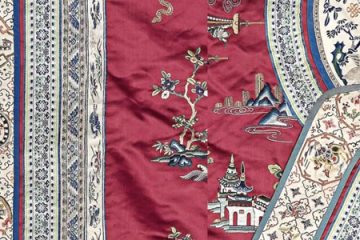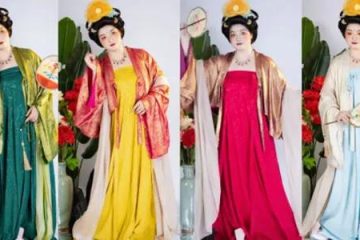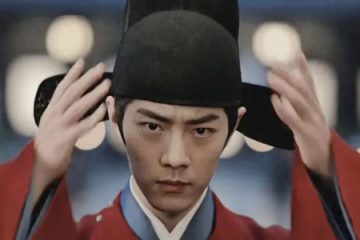Amita’s Striking Maid Look in The Litchi Road

In The Litchi Road, actress Yan Biguo’s portrayal of Lan Yu has captivated audiences—so much so that many viewers found her even more stunning than the female lead. She plays Amita’s right-hand woman: a loyal maid, trusted confidante, and top aide; she’s also the secret messenger for Zhao Zhangshu and He Cishi, the star saleswoman at the royal lychee orchard, and a dedicated drinking companion. Netizens joked: “She looked so different in each of her three outfits—I didn’t even realize it was the same person!”
Lan Yu appears in three distinct styles throughout the drama:
- A graceful Tang-style blouse and skirt for her matchmaking scene,
- A sleek and confident men’s-style round-collared robe,
- A bold, exotic blue outfit for the foreign trade mission.
Each of these looks not only reflects different facets of her character, but also gives us a glimpse into the diversity and cultural richness of the Tang Dynasty.
Ⅰ. The First Look
Lan Yu’s first Chinese outfit is a classic Tang-style parallel-front blouse and skirt ensemble. Her hair is styled in a high bun, with two loose side pieces at the front resembling the “falling bun” style (known as “倭堕” in Chinese). She wears a crossed-collar blouse paired with a chest-wrapped skirt. During the Tang Dynasty, the cultural exchange between Han Chinese and nomadic groups was frequent, and it was common for ethnic minorities to adopt Tang fashion—especially when hosting guests from the empire.

In some scenes, she also appears in a round-collared robe inspired by Central Asian styles, which was popular among women of foreign descent. In fact, Tang women’s clothing generally fell into a few key categories: narrow-sleeved blouses, blouse-and-skirt sets, Hu-style garments, and gender-bending attire like women in men’s clothing.
Everyday outfits typically included a skirt, blouse, and decorative pibo. As scholar Sun Ji noted in Costume and Makeup of Tang Women, “Skirt, blouse, and pibo were the three essential pieces of Tang women’s clothing, regardless of class or wealth.” Whether it was the athletic aesthetic of early Tang, the luxurious elegance of the high Tang, or the flamboyance of late Tang fashion, each style reflects a different phase in the dynasty’s fashion evolution.

Ⅱ. The Second Look
The second outfit features a “women in menswear” look, where Lan Yu appears in a round-collared robe, her hair tied up and adorned with a decorative hairpin—exuding a confident, heroic presence.

During the Tang Dynasty, men’s everyday clothing was heavily influenced by foreign fashion, which was then adapted into a distinctly Chinese style. Interestingly, Tang was also one of the few dynasties where women wearing hanfu male was socially accepted, particularly during the reign of Empress Wu and into the Kaiyuan era. This shift reflected both the rising status of women and the popularity of Hu-style fashion.

As noted by Ma Gao in Notes on Ancient and Modern China, “In the early Kaiyuan period, palace women would ride horses dressed in Hu-style outfits and appear in public, setting a trend that spread among commoners. By the Tianbao era, wives of scholars even wore their husbands’ boots, robes, and hats—blurring the lines between man and woman fashion.”

Ⅲ. The Third Look
The third outfit takes on an exotic, cross-cultural style, often loosely categorized in modern fashion as “Grecian,” “Indian,” or simply “ethnic-inspired.” In reality, it’s an evolution of the ancient “over-the-head dress” ( large piece of cloth with a hole in the middle for the head) style. The flowing dress paired with loose hair and beaded headpieces reflects what many today imagine as “Western Regions” fashion. However, this is more of a modern stereotype than historical accuracy.

True Tang Dynasty exotic fashion embraced a wide variety of ethnic influences. For example, in the animated film Chang An, you can see dancers wearing short-sleeved Hu-style outfits and fur-trimmed hats.

In the historical drama Flourished Peony, a woman appears wearing a bird-shaped crown—another nod to cultural diversity.
These looks aren’t just costume choices—they represent the mutual exchange and blending of different ethnic fashions during the height of Tang cosmopolitanism.


Summary
Some viewers even feel that the character Lanyu (Amita’s Maid) has, in many ways, outshined Amita in both presence and positioning. When the two appear side by side, it’s hard to tell who’s the mistress and who’s the maid! Looking at Lanyu’s three distinct outfit styles, they actually reflect three major types of women’s fashion during the golden age of the Tang Dynasty.
Which Hnafu style is your favorite? Feel free to share in the comments!



0 Comments